 |
||
|
Computer-generated
view towards Arden Corona.
|
||
| THE SURFACE OF MIRANDA | ||
| Miranda is not a particularly bright object, it has an albedo of just 0.27. The icy surface is probably contaminated with rock dust churned up by meteorite impacts. | ||
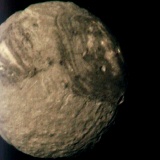 Voyager colour image of Miranda. |
||
| Miranda's surface is very chaotic. It has heavily cratered landscapes which are cut by large areas of grooved terrain. The light and dark ridges and grooves rise 2 to 3 kilometres above their surroundings. The ridged and grooved patches are called coronae (singular corona). They do not look at all like Venus coronae, but some scientists have suggested that they are formed in a similar way. | ||
| Coronae | ||
| There are three large coronae. They are named Elsinore, Inverness and Arden, after places in Shakespeare plays. Arden is nicknamed "Racetrack" and Inverness is nicknamed "Chevron". They are each slightly different and therefore it is not certain whether they formed in the same manner as one another. They vary in size from 200 to over 400 kilometres across and are roughly square in shape. | ||
 Distant view of Miranda showing the coronae of Elsinore (top), Inverness (middle) and Arden (bottom) . |
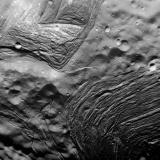 Voyager 2 image, from 31,000 kilometres, of Inverness Corona (top) and Elsinore Corona (bottom). |
|
| Inverness appears to be the most complex. It is composed of bright and dark bands. At its centre is a particularly bright V-shape or chevron. The boundaries of the corona and the surrounding cratered terrain are very clear. The ridged surface near the edges seems to overlay the older cratered landscape. The southernmost part of the corona is cut by sinuous fractures. | ||
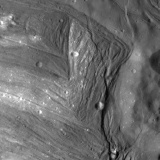 The ridges, grooves and bright patches of Inverness Corona. |
||
| Elsinore has the straightest longest grooves. Not all of it can be seen, but the interior, highlighted by a low sun angle, contains some rugged terrain characterised by ridges and grooves. These are more chaotic and hummocky than the bounding ridge belts. The corners of Elsinore are curved, unlike those of Inverness which are quite angular. There is no satisfactory explanation for this. As well as the sharp bowl-shaped craters, there are several very faint craters which are nearly erased by the ridges and grooves. | ||
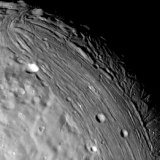 The ridges and grooves of Elsinore Corona, and the bright crater Stephano. |
||
| Arden Corona is the largest corona, the ridges and grooves seem to be more widely spaced than those of the Inverness or Elsinore. It has curved edges like Elsinore. Like Inverness corona it has bright areas. These though, are irregular and patchy. | ||
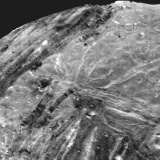 Voyager view from 31,000 kilometres of Inverness Corona (top) and Arden Corona (bottom). |
||
| Tectonic features | ||
| Much of the cratered terrain is gently rolling but there are some regions which are extremely rugged. There are valleys and scarp faces up to 5 kilometres high, though 2 to 3 kilometre escarpments are more common. These are collapse zones. Where there is extension of the surface, exposed cliff faces are cut back by slumping along fault lines. At the foot of such scarps is usually a blocky jumble of collapsed material. | ||
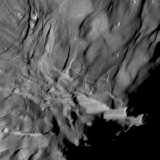 Alonso Crater (left) and the cliffs of Verona Rupes (bottom right). |
 Voyager 2 image of Verona Rupes showing cliffs up to 5 kilometres in height. |
|
| All the terrains are cross-cut by faults. There are faults which run through several different terrain types. Down-thrown blocks which form trenches or "graben" are not unusual. These shows that some extension of the surface has taken place. | ||
| Because Miranda is quite small, ice probably only assumes its normal state and not the more compact phases which can exist under the high pressures deep inside larger bodies. Therefore as Miranda cooled, it expanded, extending and fracturing the surface.There are also fractures which are thought to have been formed as sections of the surface rubbed past each other. | ||
| Craters | ||
| Larger craters on Miranda are 5 to 30 kilometres across and bowl shaped. There are many more smaller craters. There are no very large craters or very complex craters. Some cratered regions are populated with craters which are subdued and have rounded rim crests. In other areas craters with sharp well defined rims predominate. The grooved terrains contain fewer impacts and therefore would appear to be younger. | ||
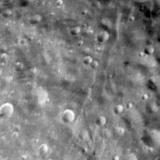 The cratered terrain of Miranda's Manta Regio. |
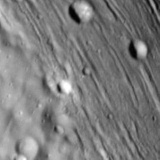 Bowl shaped craters in Elsinore Corona. |
|
|
|
||